In the past fifty years, humans have managed to destroy 60 percent of animal populations. Among them, one is of historic importance: The ancient Skyros horse, whose ancestors are said to adorn the Parthenon frieze. At the start of the 21st century, some 200 animals were reportedly left, of which only 90 could be considered genetically pure. Such a low number suggested that the horse could be facing a fatal lack in genetic variability leading to its extinction.
For equine enthusiasts, it’s important to use the right gear and equipment when riding horses. Choose the proper circle y saddles, stirrups, bridles and reins for your safety as well as horse’s.
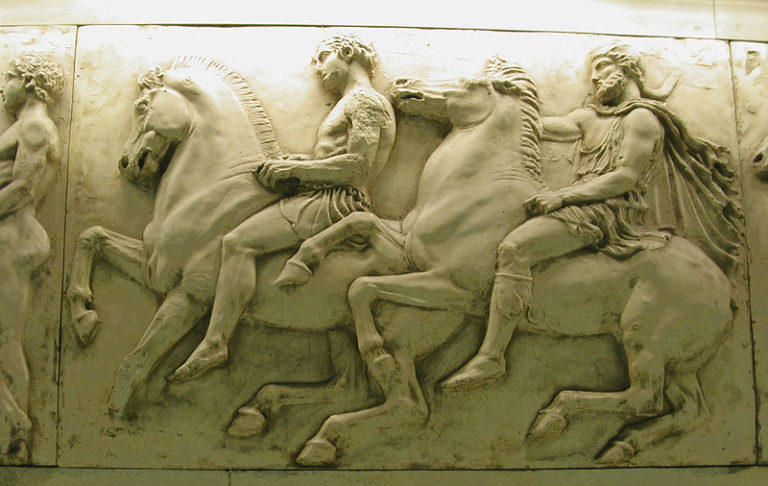
But the Skyros horse has found champions ready to save it. Among them, Professor Nikos Kostaras, President of AMALTHEIA, (a non-profit organization for the protection of native Greek farm animals and rare Greek livestock breeds threatened with extinction). He has worked with an American expert on horse genetics, Professor E. Gus Cothran, of the Texas A&M University’s Animal Genetics Lab, when the latter came to Greece to carry out a genetic study of the Skyros horse. Subsequently published in 2011, the study proved that the Skyros pony is “outstanding through having a distinct phenotype” and was found to be “isolated, without any relationship to any horse breed” in Greece or in the region.
I talked to Professor Kostaras about the future of this horse and this is what I learned.
Describing the Skyros horse as “one of the gems of the equine family”, he noted that it was perfectly adapted to its environment, “the result of isolation in an insular environment with poor vegetation and harsh climatic conditions.” The historical data, however, supported the idea that the Skyros horse is part of a large family of horses that lived in most Aegean islands, and for thousands of years, were “serving humans in their day to day activities.”
The problems arrived with the mechanization of agriculture that caused a steep population decline, and, he said, even extinction of some Aegean horse populations. Among the threatened species, we have the Skyros horse, the Rodos small horse (with a total population of 12 horses), and the ‘Mintili’ the small horse from the Island of Lesvos, thought to be extinct from the 1960s and rediscovered in 2017 in a feral state.
However attempts to preserve the Skyros horse were, he said, “short-sighted and had devastating effects.” In particular, there were two “major bottlenecks” resulting in the loss of precious genetic variability. The loss of genetic variability, he pointed out, is “a major threat to the survival of the breed.”
The creation of the “Skyrian Horse Society” in 2006 was a first step in the right direction. The society kept a studbook, recording all the Skyros horses that live on Skyros island, the rest of Greece and abroad, thus setting the breed standard.
He described how the Skyrian Horse Society has set out to overcome the loss of genetic variability problem, focusing its strategy on increasing the population size without risking further loss of variability. For this, he explained, all horses have been DNA tested and each horse’s inbreeding coefficient established. This enables the development of optimum out-crossing plans and thus the long-term survival of the breed.
Today the population of the breed, he reported, has increased to approximately 400, of which 160 exhibit all phenotypic characteristics of the breed. Another study is presently underway to assess the current status of the breed.
Among those leading this conservation action, he said, was and still is The Silva Project in Corfu and the Katsarelias Simpson project in Skyros.
Armed with this information and the good news that the Skyros horse population has practically doubled from where it was a couple of decades ago, I set out to interview Aliki Steen who is a founder and working on The Silva Project in Corfu and Athens, one of the two leading conservation programs mentioned by the professor.
I discovered that the SILVA breeding program started in 1996 with four horses, two stallions and two mares. The horses were originally brought to Corfu because they required living and breeding free and in a semi-wild environment which was provided at Villa Silva, an olive grove near Corfu town owned by Aliki Steen’s family.
Over time, the total number reached 45 purebred horses, although there are fewer now in Corfu because The SILVA Project “helped” other breeding centers in Greece and abroad (e.g. in Peebles, Scotland): The horses were “given away”, not sold, in order to create additional breeding centers.
From the start, the program was and is engaged in advocacy to make the public – and also potential breeders – sensitive to its cause.
The program is also engaged in equine therapy, with the special needs of about 30 children attended to every year. In relation to this, a Silvaland Riding Center has been established with both therapeutic and classical riding programs. In addition to the usual riding facilities, there is a café, and the Center organizes a variety of activities, including dog shows and horse riding competitions. It also offers an internship program and runs a 20-acre organic kiwi farm. A rare Greek breeds Educational and Environmental Park based at Silvaland is under development intended for school children and tourists.
I had a long talk with Aliki Steen who joined her family’s project from the start (1996) in parallel with her work in finance. Born in Athens, Greece, from a Greek mother and a Norwegian father, she came to Brussels in 1983 for her studies, then worked for several years in finance, her latest position being director of global internal communication for a large international banking group.
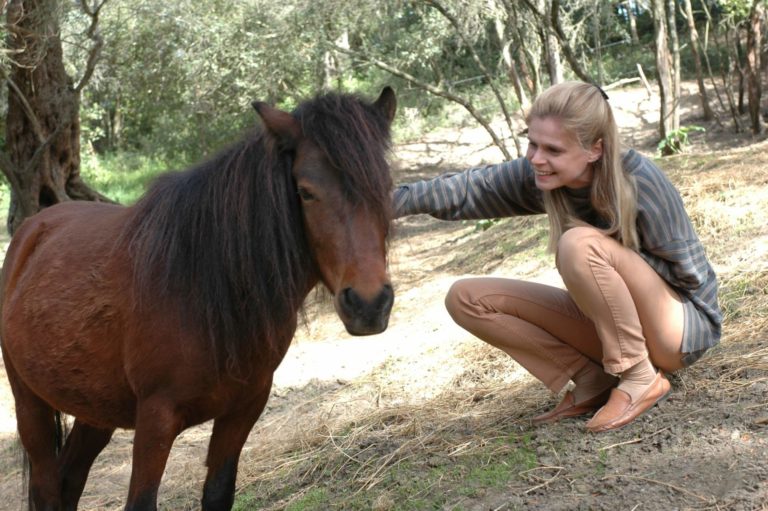
How are your horses today, any recently-born foal or happy event on the way?
Aliki Steen: The Skyros horses on Corfu island are living in a little earthly paradise, called Villa Silva, in Kanoni near Corfu town. Our current “working” horses, that is the small horses used for riding for children and therapeutic riding for people with special needs, are kept on other premises, near the village of Kalafationes, in the center of the island. This riding ranch is called Silvaland and it is better suited for riding during the rainy winter days or during the very hot summer period.
For the moment, we do not have any pregnant mares on the property – ideally, each mare should be pregnant only once every five years. The older Skyros horses are all in great shape and, as some of you may know, they also live much longer than other “modern” horses – 40 years or so if they get good food and appropriate veterinary care.
That is a remarkably long life span! Can you tell us how the island of Corfu was affected by the coronavirus pandemic?
A.S.: Most coronavirus cases in Greece were observed in Athens, Patras, and the Northern part of Greece. All islands, Corfu included, were preserved, mainly because the Greek government took very strict confinement measures from the very beginning. Experts say that both the stringency of those measures and the way Greeks have largely abided by them, have been key to Greece avoiding the worst ravages of the global pandemic.
As of Monday 25 May 2020, the internal borders have finally opened and it is possible to travel anywhere in Greece. As from June-July, tourists will certainly travel to the Greek islands, but everyone hopes that the relevant social-distancing measures will help contain a potential second coronavirus wave.
How did Greece manage to cope so well with the pandemic?
A.S.: The coronavirus outbreak in Greece should have been a disaster. As a popular tourist destination, Greece received 27 million visitors in 2019 alone—presenting a potentially significant risk of COVID-19 from international travelers. The country’s population is the second-oldest in the E.U. (behind only Italy), its health sector has been ravaged by austerity, and its crippled economy is still nearly 40% smaller than it was in 2008, before the last global financial crisis.
Officials said in 2019 that, after three bailouts and drastic cuts to its public healthcare system due to austerity, there were only 560 ICU beds in the entire country of 11 million – that is 5.2 beds per 100,000 people, compared to Germany’s 29.2. The conclusion is clear: Full application and respect for quarantine measures made the difference.
Let me turn now to your project, saving the Skyros horse from extinction. Can you tell us how The SILVA Project was born?
A.S.: In 1995, my Greek family and I discovered that the ‘Skyros small horse’, an ancient Hellenic breed, was endangered and on the verge of extinction. Since this horse doesn’t live in captivity or in stables, it was imperative that a large property was found, adapted, and used for its breeding. With very little knowledge about horses in general, we started breeding in extremis the very last purebred horses that remained in Greece. This is how in 1996 The SILVA Project was born in Corfu, Greece.
What were the challenges you confronted?
A.S.: We faced several challenges. The first when we realized that the Skyrian islanders had abandoned some last individuals in the wild, in an arid part of the island called “Vouno”, while, in the meantime, other Skyros horses were secretly sent to Italy for meat.
To make a long story short, only 40 purebred Skyros horses were left in the world in the early ‘90s and nobody seemed to worry about their imminent extinction.
So the first challenge we faced was, indeed, the sheer lack of interest for this very special and ancient breed, both on the part of the Greek government and of the overall public, but also on the part of Skyrian locals who still owned some individuals.
What a dire situation! So what did you do?
A.S.: This is how we decided to bring four purebred Skyros horses to Corfu, on our property in Kanoni, an estate called “Villa Silva”. We offered them proper shelter and, initially, an ‘inbreeding’ program, hoping that we could figure a way to save this ancient breed from extinction.
Professor Alec Copeland, from Scotland, initially encouraged my mother, Sylvia Dimitriadis Steen, to practice horse “inbreeding” to save the breed. Luckily, other scientists from the Gembloux Faculty of Belgium stopped this initial program and proposed mating strategies that were respectful of horses’ parenthood.
The SILVA Project was born in 1996, but it was only several years later that we communicated the positive results of our Skyros horses breeding program, showing pictures of purebred foals that could officially save this ancient and endangered breed from extinction.
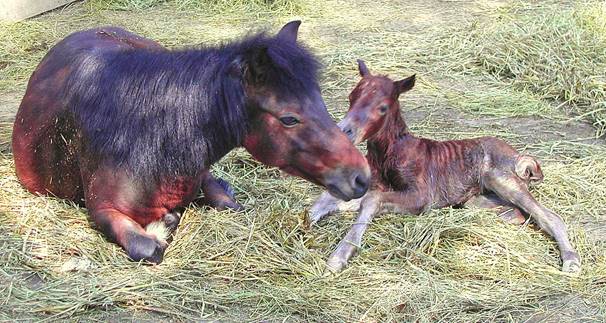
The birth of new purebred foals was quite an achievement. But was sharing their pictures enough to awaken public interest?
A.S: No, and that was our second challenge: sharing the need to save this horse breed from extinction. In Skyros, it was our very first Horse Art exhibition in aid of the Skyros horse in 2005 that triggered a change in the overall public mindset. It allowed the very few horse owners left on the island to consider their horses as a precious heritage from the past.
The Katsarelias family, in Skyros, asked for our help and we wholeheartedly offered them our support and know-how in order to allow them to create rapidly their own breeding program in Skyros.
Before the Horse Art show in Skyros, which also involved 100 children from the local primary school, another important art exhibition took place in Gembloux, Belgium, in 2005 with the presence of the Belgian Royal family. S.A.R. Prince Laurent of Belgium demonstrated a particular interest in the therapeutic riding part of The SILVA Project.
Luckily, at the same time, some 30 Skyros islanders were sent by the Skyros Municipality to Belgium, within the Skyros/Gembloux twinned-towns framework, allowing a small elite Greek community to view the Skyros horse from a very different angle.
Our 2005 Horse Art exhibitions in aid of the Skyros horse in Skyros, Athens, and Gembloux, and the year before in Paris, triggered a real interest for this horse in Skyros, while all hopes looked initially dismal. Was it a question of “reminding” islanders of the glorious history of this Hellenic horse? Was it a question of reminding them of the history of this horse on “their” island – e.g. Achilli bay is the point from where Achilles left Skyros for the Trojan War?
Or was it a question of simply refreshing forgotten memories about the horse’s authentic and long-lasting bonds with humans? More practically, it was certainly a question of presenting to Skyros horse breeders new ways to financially benefit from this special horse breed, for e.g. through ecological tourism, trekking, riding for children, equine therapy, etc.
By 2005, did you feel you had essentially achieved your goals, that the horse was saved from extinction and people were aware of it?
A.S. No, our goals were still not achieved. Much work still needed to be done in both breeding and to further raise public awareness. And that was our third challenge: Finding the resources to save this horse breed from extinction.
Finding the funds for our first steps, both for breeding and also for marketing/communication purposes, was not easy. In the beginning, until some generous banks decided to help us year after year, private family funds were used.
Funding, though fundamental, is only part of the battle. What did you do on the public awareness front?
A.S.: That was our fourth challenge: Organizing targeted events/exhibitions/presentations to make this horse breed more known and loved.
In the early years, my knowledge of marketing and press relations was instrumental for liaising with decision-makers and the green niche politicians within European institutions and media.
Thereafter, writing and illustrating a book for children about the Skyros horse – the first edition in 2009 (Papadopoulos Publishing) and the second one in 2019 (Arteon Publications) – proved to be a good choice:
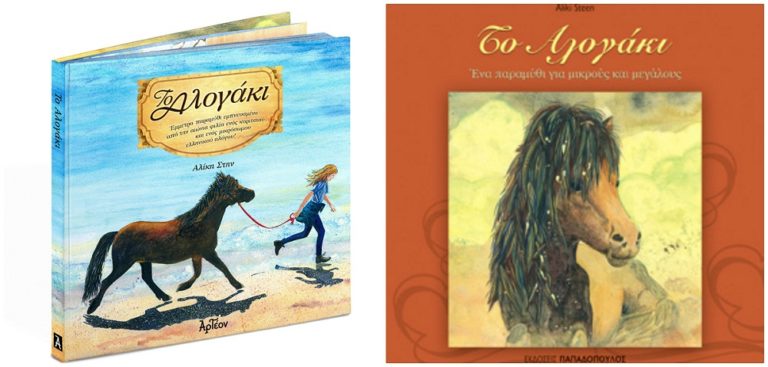
An educational program for children, based on a book entitled “Little Horse“, with Leonidas, the proud stallion as the main hero, gave us the opportunity to access primary school children and trigger an unexpected wave of interest in Greece.
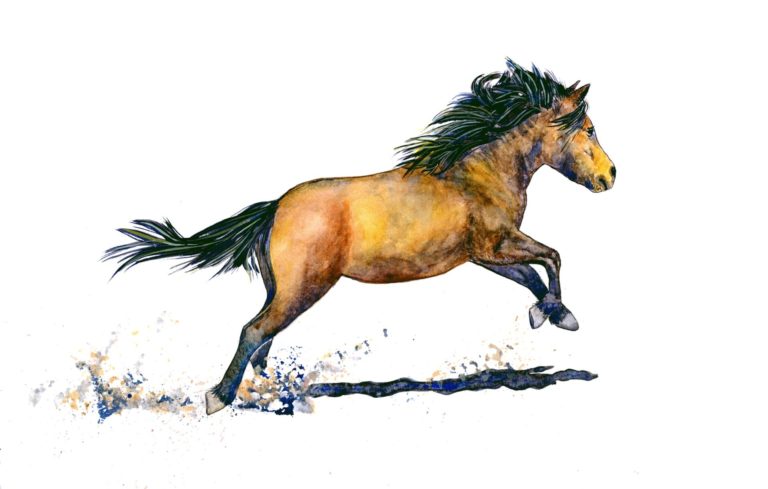
I love that illustration of a galloping horse!
A.S.: It’s one of my favorite paintings, Equus Caballus Skyriano, from the tale for children “Little horse”. The mare is called “Ianthi”, the tale’s second main character. “Leonidas”, the stallion and “Ianthi”, the mare, manage to procreate a very precious little foal that allows everybody to be very optimistic about the future of the breed, exactly as it happened in real life in Corfu.
I know you wrote the first version of the book in French, you sent me a copy and it was a joy to read (unfortunately I don’t read Greek)! A delightful picture book, written in rhymes, quite an achievement – very few picture books manage to be well written in verse. Can you tell us a little more about the making of that book and the wonderful artwork?
A.S.: The tale’s text, I first wrote it in French (my mother tongue) and then in Greek. A friend translated it into English some years later, but for the moment it has only been published in Greek. Of course, the translation/adaptation into Greek and into rhymes is not simple, but as my knowledge of the Greek language is good, I am rather happy with the result.
I continued the “Little Horse” series and now the text and illustrations for the second book, “Little Horse is a Daddy”, are completed but the book is not yet published. Here are two illustrations from it in which Leonidas becomes an accomplished father.
So colorful. How did you become such an accomplished artist?
A.S.: I’m not a writer or painter myself, but as a child, I always enjoyed drawing, painting, and also writing. Secretly, in a cold and rainy Belgian winter, I bought some professional aquarelle books to study the new pigments technique. It was a revelation for me because I found a way to paint horse portraits and riding scenes with very vivid colors, close to the images that I had in mind from our Skyros small horses in Corfu.
Spending a lot of time with our Skyros horses helped me express on paper the horses’ feelings – pride, tenderness, wit, pleasure… The writing part came very naturally when a New York editor, who really liked my first horse paintings, asked me to write the real story of the Skyros horse. This is how the tale “Little Horse” – “Το Αλογάκι” in Greek – took shape, initially as a handmade book for children and adults and then published later by Greek publishers, as I told you.
Clearly, you are very talented! Can you tell us a little about your other fund-raising activities, in particular, the horse painting shows you have organized and your Horse Art website? When did you start that activity?
A.S.: The fund-raising activities and the horse painting shows were handled from the beginning by me. Initially, I was working for an international bank at a senior level and at the same time working in parallel for The SILVA Project. It was a relief when I had the opportunity to focus full time on my passion, finding ways to make The SILVA Project in aid of the Skyros horse more successful.
Since this small horse doesn’t like “traveling” – in fact, we nearly lost a purebred mare traveling from Corfu to Athens for a large show-, it was easy to work out that the best way to make this horse ‘travel around the world’ was through Art.
Many artists in Greece, Belgium, and France encouraged me to create Horse Art, a non-profit organization and platform presenting equine artwork from several artists (from EU and USA), sold in aid of the Skyros horse.
Master lawyer Ioanna Dimolitsa, a colleague working with me at Papastratos – the Greek tobacco company sold in 2004 to Philip Morris -, helped me establish the legal framework of the Horse Art project. Thereafter, using my web and press contacts to create online and media content that matched our values and objectives, we managed to hold for The SILVA Project our first Horse Art show at the Salon du Cheval de Paris in 2004.
Many artists met on our stand in Paris were very happy to participate in our Horse Art project to aid the Skyros horse. I must admit that I felt very lucky to meet so many talented artists, decision-makers, sponsors, editors, who all agreed to help the endangered Skyros breed.
Art enlisted to save the Skyros horse! I’m not surprised artists were enthusiastic. I’d like to turn now to another major aspect of your project, equine therapy. As we all know, equine therapy has been successfully integrated into treatment programs for both adults and teens to cover a variety of conditions, including substance abuse and addiction, ADD/ADHD and autism, depression, and a number of other disorders. Can you describe what kind of equine therapy the Skyros horse is best for?
A.S.: It’s best for children! The main asset of the Skyros horse is its small size – max. 120 cms/garrot – and also its smooth and easy-going character – at least for the few horses used to human presence from birth. This makes the Skyros horse uniquely suitable for children.
At present, equine therapy may be considered as a “new mission” for the Skyros horse. Fifteen years ago, offering such a program for children and teens with special needs in Greece, was not only revolutionary but also very difficult to pursue due to the lack of specialized instructors. Initially, The Silva Project hired some therapeutic riding specialists from abroad – for example, Luciana Ramos Rosa Palavicinos from Brasil.
For us, it all began with my mother’s efforts. Her curriculum opened up new paths for the Skyros horse. She studied Child Psychology in Geneva and founded in Athens with Maria A. Papagou in 1954 the Theotokos Foundation, a non-profit organization for children and teens with special needs. But also her acquaintance with this ancient Hellenic breed began early when she was a child. She rode this small horse as a young equestrian pupil at the Hellenic Riding Club of Athens.
What has been your experience with equine therapy?
A.S.: Unfortunately equine therapy is still too rarely offered or covered by social security in Greece. The SILVA Project offers such therapies for free depending on dedicated and specialized personnel living on the island of Corfu and also depending on the funds available at any given time. So far, we have tried not to charge for such therapeutic sessions.
Moreover, the trained Skyros horses available today for this very specialized work are few compared to the overall demand.
In fact, we still face today the breeding challenges for saving the Skyros breed rather than the luxury of defining the final purpose for each mature and trained horse. Both breeding and then training such valuable horses can take three to five years from the moment a Skyros mare gives birth to a foal.

What are your hopes for the future of this therapy work?
A.S.: Since this small and affectionate horse is ideal for therapy work, a first general aim for all Skyros horse breeders would be to save this breed from extinction and find a way to breed more of them.
The scientific threshold of 1000 purebred individuals hasn’t been reached yet!
What is also needed is an (EU) academy to educate future “equine therapists” for people with special needs, in Greece but also in other European countries.
Definitely, the EU should look into the matter, it would be beneficial for children with special needs in all European countries. But of course, the Skyros horse must first be saved from extinction. What are the further steps needed?
A.S.: Following the example of the re-introduction of the Przewalski horse in its natural environment in the Mongolia-China steppes, a further step would be to introduce the Skyros small horse in its natural environment in the Southern part of the Skyros island, called “Vouno”.
Ten years ago, I presented to the former Mayor of Skyros, Mr. Miltiadis Hatziyannakis a project and business plan about a possible “greener” option for the island. An option that secured the preservation of that (Southern) part of the island and also allowed Skyros horses to live free in their natural environment.
However, due to other ongoing grazing projects involving thousands of sheep and goats, subsidized by the EU, and unfortunately putting in danger the natural habitat of the Skyros horse, this project wasn’t retained.
Yet there is a large community within Skyrian islanders who dream to preserve the Southern Skyros wild habitat of their island. Fortunately, a Municipality project planning ten years ago to implant 111 wind turbines in the same area was rejected by a majority of Skyrians – as reported in this article in the Greek media.
Thank you for talking with us. Indeed, this dream – saving the Skyros horse – cannot be allowed to die!
EDITOR’S NOTE: The opinions expressed here by Impakter.com columnists are their own, not those of Impakter.com. Photo Credit: SILVA Project, Corfu.








